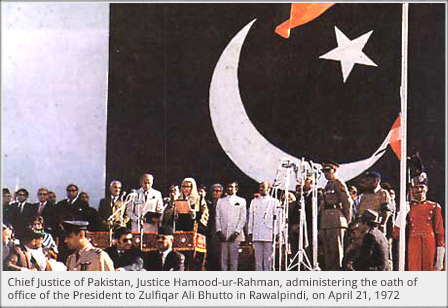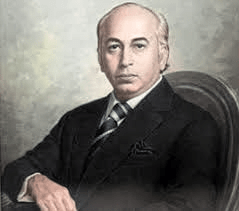After the disastrous war with India that ingloriously concluded in December 1971, Pakistan had to face its greatest crisis since Independence. The dismembered Pakistan was left only with the four Provinces of West Pakistan; Punjab, Sindh, N. W. F. P. and Baluchistan. East Pakistan was now independent. Pakistan had lost a whole province of 70 million, 56 percent of the total population, and over 54,501 sq. miles of territory. There were 93,000 prisoners of war in India and Bangladesh. Pakistan’s international credit was depleted.President Yahya tried to act in a militaristic manner to impose law and order but the people’s patience had been exhausted by this time. Military leadership had been discredited. Disillusionment, uncertainty and pessimism prevailed. People were no longer prepared to tolerate misgovernment. The public severely criticized and accused President Yahya and his Government for ineptness and inability that culminated with the 1971 national debacle.
Faced with these difficulties, President Yahya ceded power to Zulfiqar Ali Bhutto, Chairman of the Pakistan Peoples Party that had won the majority votes in the 1970 elections in West Pakistan. On the request of Zulfiqar Ali Bhutto, on December 6, 1971, Yahya Khan installed a civilian setup at the Centre and Nurul Amin, a prominent Bengali politician who was against Mujib-ur-Rahman, was made the Prime Minister. Z. A. Bhutto was made Deputy Prime Minister on the same day. Nurul Amin remained Prime Minister till December 20, 1971, the day when Bhutto took over as the civilian Chief Marshal Law Administrator.

A Pakistan International Airline flight was sent to fetch Bhutto from New York, who at that time was pleading Pakistan’s case before the United Nations Security Council on the East Pakistan Crises. Bhutto returned home on December 18, 1971. On December 20, he was taken to the President House in Rawalpindi where he took over two positions from Yahya Khan, one as President and the other as Chief Martial Law Administrator. Thus he was the first civilian Chief Martial Law Administrator of the dismembered Pakistan.
The new President inherited a disturbed and desperate nation sobbing and suffering from an intangible loss of confidence. In this dismal hour, he addressed the nation and promised to fight back. He vowed to build a new Pakistan.
Bhutto’s intentions to restore national confidence were in several shapes. He spoke about democracy, a new Constitution, and a modified federal and parliamentary system. He took steps to stabilize the situation by successfully negotiating the return of the 93,000 prisoners of war and a peaceful settlement with India. He took steps to ameliorate poverty and to revitalize the economy, industry and agriculture. He gave the third Constitution to the country and established civilian authority over the armed forces in the political setup.
In early 1972, Bhutto nationalized ten categories of major industries and withdrew Pakistan from the Commonwealth of Nations and S. E. A. T. O. On March 1, he introduced extensive land reforms. On July 2, 1972, he signed the Simla Agreement with India for exchange of the occupied territories and release of Prisoners of War.
After the 1973 Constitution was promulgated, Bhutto was elected by the House as the Prime Minister of Pakistan. He was sworn-in on August 14, 1973.
This article was last updated on Sunday, June 01, 2003[/fusion_text]






